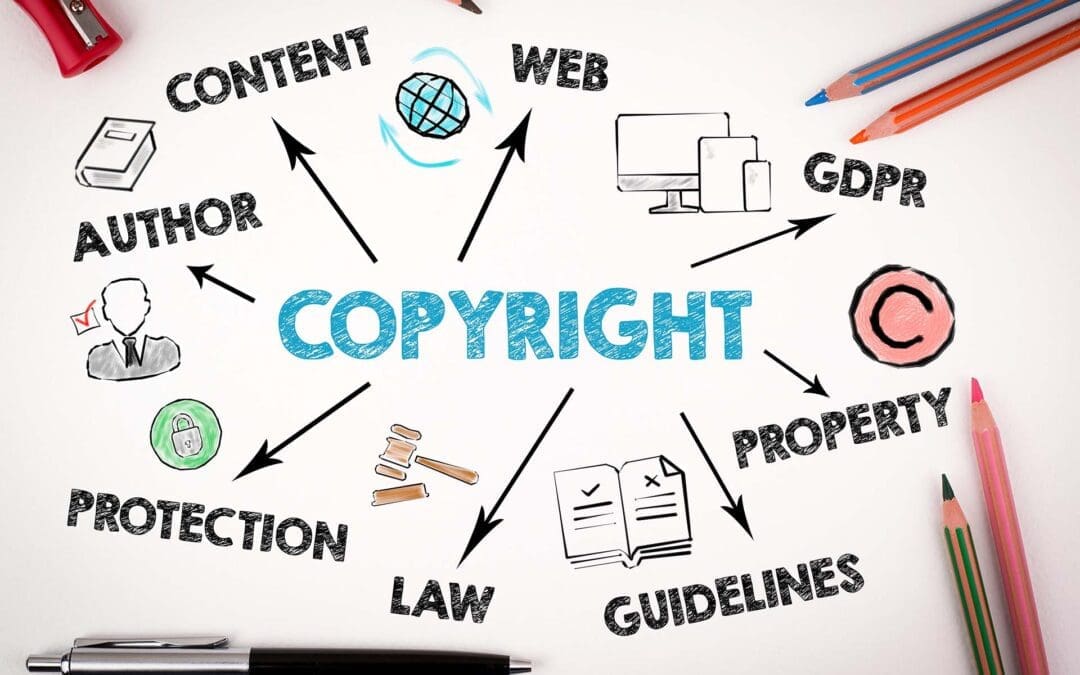Receiving a copyright infringement notice can be alarming, especially if you’re unaware that an image or content on your website violates someone else’s intellectual property rights. Failing to respond appropriately could lead to legal action, fines, and even the removal of your website from search engines or hosting platforms.
This is an educational guide providing information to consider about handling copyright infringement notices and DMCA takedown requests. This article is not legal advice and if you have concerns about an infringement notice please contact your business attorney.
What is a Copyright Infringement Notice?
A copyright infringement notice is a formal complaint sent by the copyright owner or their representative, notifying you that you are using their copyrighted material without permission. This can include images, videos, text, music, or any other form of content protected under copyright laws.
Typically, these notices will demand that you remove the infringing content or face legal consequences. The Digital Millennium Copyright Act (DMCA) is the governing law in the United States for handling these claims, providing a structured process for both copyright owners and alleged infringers.
Beginning in the late 2010s businesses with large libraries of visual content began organizing their operations more efficiently and actively sending out notices. In the 2020’s it became common for a large library copyright holders to contract with a company that actively seeks infringement to collect fees and penalties where the copyright holder earns a percentage of that revenue.
Steps to Take When You Receive a Copyright Infringement Notice
If your company receives a letter or email stating that you’re using a copyrighted image or other content without permission, you can use these steps to address the situation carefully and promptly.
1. Consider the Claim
Before taking any action, it’s important to consider the legitimacy of the claim. Some copyright infringement notices can be scams or sent in error.
Here’s how to verify the claim:
- Check the Image Source: Determine where the image or content originated from. If you sourced the image from a stock photo site, check the licensing terms to ensure you had the proper rights to use it. This is especially important if the image was provided by a third party, such as a contractor or freelancer.
- Review the Letter: Examine the details of the copyright notice. Does it clearly state the image or content in question? Is the sender the rightful owner or their legal representative? Look for contact information and verify it by searching for the copyright owner’s details online.
Pro Tip: Be cautious of fake DMCA notices that attempt to scam businesses into paying fees or removing content. Always cross-check the legitimacy of the sender before taking action.
Many times the photo identified will be on a blog article or older page on the website. If the source of the image is not known or certain but likely not something created by the business itself, it’s best to act on Step 2. If the photo is clearly owned by the business (i.e. was taken by a staff member), then the letter may be a scam.
It may be the case that the website was built for the business by a website agency that is no longer in the picture. If this is the case it’s best to move on to Step 2 since you are not likely to have information about the source of the image.
If the current design was created by the current marketing agency your business works with it’s possible they have proof of copyright or a membership to a stock media library from which they have a license to use the material.
2. Remove the Infringing Content Immediately
Once you’ve confirmed the claim is valid or reasonably likely to be valid, your next step should be to remove the infringing content from your website. If you work with a website agency you can contact them for assistance completing this task and providing a new photo or image to go in that location.
Steps to remove the content:
- Take Down the Image or Content: Whether it’s an image, video, or piece of text, remove it immediately to show good faith in resolving the issue.
- Replace with Licensed or Original Content: If the content is crucial to your website (e.g., a hero image), replace it with a properly licensed image from a stock photography site or original content you own.
By taking swift action, you demonstrate that you’re committed to resolving the issue, which can help mitigate risks if the situation escalates.
3. Contact the Copyright Owner
After removing the infringing content, you may want to reach out to the copyright owner or their representative to make them aware. Depending on the situation you may choose to skip this step.
Pro Tip: Document all communications with the copyright holder in case the issue resurfaces later on.
4. Review the Legal Implications
If the copyright infringement notice includes a demand for financial compensation or threatens legal action, it’s wise to consult with an attorney who specializes in intellectual property law.
What to consider:
- Legal Consultation: A lawyer can help you understand the potential risks and the validity of the copyright claim. They can also help you negotiate with the copyright holder if necessary.
- Assess the Severity: If the infringement is minor and you’ve acted quickly to remove the content, legal consequences may be avoidable. However, for more severe or repeated violations, a lawyer can help you navigate any further legal implications.
Pro Tip: Acting swiftly to resolve the issue can often prevent costly lawsuits or fines.
How to Prevent Future Copyright Issues
One of the best ways to protect your business from copyright infringement claims is to implement a proactive strategy for managing content on your website.
1. Use Properly Licensed Images
Make sure all images, videos, and other media on your website are properly licensed. This may involve:
- Using Stock Photo Websites: Utilize reputable stock photo websites that offer royalty-free or properly licensed images. Popular choices include Shutterstock, Adobe Stock, and Unsplash.
- Hiring a Photographer or Designer: For unique content, consider hiring a professional photographer or graphic designer to create original media specifically for your business.
Pro Tip: Always review the licensing terms before using stock images, as some may have restrictions on commercial use.
Pro Tip: Ask your marketing agency or website provider where they get stock images from and if that source allows for their clients to use those photos.
If you need assistance in this area please contact us.
2. Implement an Internal Content Policy
To avoid accidental copyright violations, it’s important to establish an internal content policy for your team.
Key elements of a content policy:
- Require Licensing Verification: Ensure that all images or media used on your website are verified for proper licensing or come from a stock content provider
- Create an Approval Process: Have a designated team member review all content before it’s published to ensure compliance with copyright laws.
- Maintain Records of Licenses: Keep a record of all licenses for stock images, videos, and other media used on your website in case of future disputes.
Pro Tip: Educate your employees and contractors about copyright laws and your internal content policy to prevent unintentional infringements.


